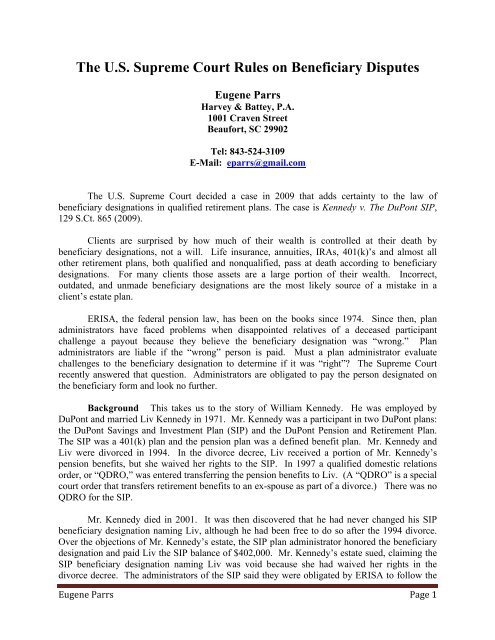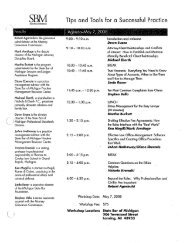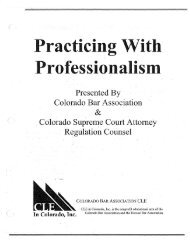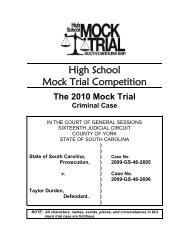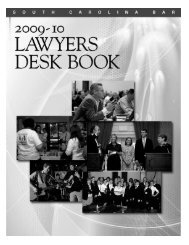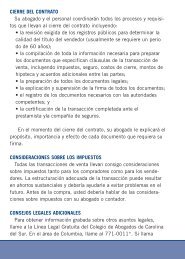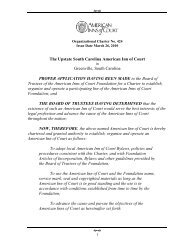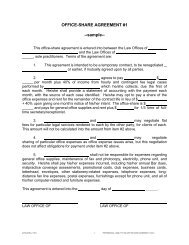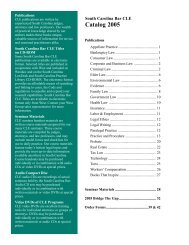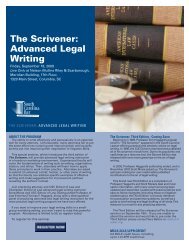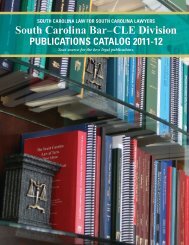Probate, Estate Planning & Trust Section - South Carolina Bar ...
Probate, Estate Planning & Trust Section - South Carolina Bar ...
Probate, Estate Planning & Trust Section - South Carolina Bar ...
You also want an ePaper? Increase the reach of your titles
YUMPU automatically turns print PDFs into web optimized ePapers that Google loves.
The U.S. Supreme Court Rules on Beneficiary Disputes<br />
Eugene Parrs<br />
Harvey & Battey, P.A.<br />
1001 Craven Street<br />
Beaufort, SC 29902<br />
Tel: 843-524-3109<br />
E-Mail: eparrs@gmail.com<br />
The U.S. Supreme Court decided a case in 2009 that adds certainty to the law of<br />
beneficiary designations in qualified retirement plans. The case is Kennedy v. The DuPont SIP,<br />
129 S.Ct. 865 (2009).<br />
Clients are surprised by how much of their wealth is controlled at their death by<br />
beneficiary designations, not a will. Life insurance, annuities, IRAs, 401(k)’s and almost all<br />
other retirement plans, both qualified and nonqualified, pass at death according to beneficiary<br />
designations. For many clients those assets are a large portion of their wealth. Incorrect,<br />
outdated, and unmade beneficiary designations are the most likely source of a mistake in a<br />
client’s estate plan.<br />
ERISA, the federal pension law, has been on the books since 1974. Since then, plan<br />
administrators have faced problems when disappointed relatives of a deceased participant<br />
challenge a payout because they believe the beneficiary designation was “wrong.” Plan<br />
administrators are liable if the “wrong” person is paid. Must a plan administrator evaluate<br />
challenges to the beneficiary designation to determine if it was “right”? The Supreme Court<br />
recently answered that question. Administrators are obligated to pay the person designated on<br />
the beneficiary form and look no further.<br />
Background This takes us to the story of William Kennedy. He was employed by<br />
DuPont and married Liv Kennedy in 1971. Mr. Kennedy was a participant in two DuPont plans:<br />
the DuPont Savings and Investment Plan (SIP) and the DuPont Pension and Retirement Plan.<br />
The SIP was a 401(k) plan and the pension plan was a defined benefit plan. Mr. Kennedy and<br />
Liv were divorced in 1994. In the divorce decree, Liv received a portion of Mr. Kennedy’s<br />
pension benefits, but she waived her rights to the SIP. In 1997 a qualified domestic relations<br />
order, or “QDRO,” was entered transferring the pension benefits to Liv. (A “QDRO” is a special<br />
court order that transfers retirement benefits to an ex-spouse as part of a divorce.) There was no<br />
QDRO for the SIP.<br />
Mr. Kennedy died in 2001. It was then discovered that he had never changed his SIP<br />
beneficiary designation naming Liv, although he had been free to do so after the 1994 divorce.<br />
Over the objections of Mr. Kennedy’s estate, the SIP plan administrator honored the beneficiary<br />
designation and paid Liv the SIP balance of $402,000. Mr. Kennedy’s estate sued, claiming the<br />
SIP beneficiary designation naming Liv was void because she had waived her rights in the<br />
divorce decree. The administrators of the SIP said they were obligated by ERISA to follow the<br />
Eugene Parrs <br />
Page 1


